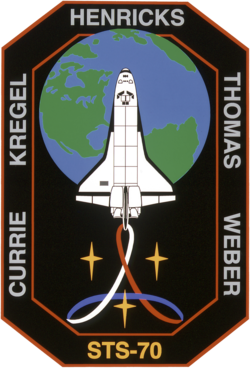Nancy J. Currie
| Nancy Jane Currie | |
 | |
| NASA-astronaut | |
|---|---|
| Född | 29 december 1958 Wilmington, Delaware |
| Tid i rymden | 41 dagar, 15 timmar, 32 minuter |
| Urvalsgrupp | Astronautgrupp 13 |
| Uppdrag | STS-57, STS-70, STS-88, STS-109 |
| Uppdragsemblem | |
Nancy J. Currie, född 29 december 1958 i Wilmington, Delaware, är en amerikansk astronaut uttagen i astronautgrupp 13 den 17 januari 1990
Rymdfärder
Källor
- ”Biographical Data” (på engelska) (PDF). NASA. januari 2016. https://www.nasa.gov/wp-content/uploads/2017/11/currie.pdf?emrc=521c12. Läst 4 maj 2024.
Media som används på denna webbplats
Designed by the crew members, this patch commemorates the first assembly flight to carry United States-built hardware for constructing the International Space Station (ISS). This flight's primary task is to assemble the cornerstone of the Space Station: the Node with the Functional Cargo Block (fgb).
The rising sun symbolizes the dawning of a new era of international cooperation in space and the beginning of a new program: the International Space Station. The Earth scene outlines the countries of the Station Partners: the United States, Russia, those of the European Space Agency (ESA), Japan, and Canada. Along with the Pressurized Mating Adapters (PMA) and the Functional Cargo Block, the Node is shown in the final mated configuration while berthed to the Space Shuttle during the STS-88/2A mission.
STS-57 Endeavour, Orbiter Vehicle (OV) 105, crew insignia (logo), the Official insignia of the NASA STS-57 mission, depicts the Space Shuttle Endeavour maneuvering to retrieve the European Retrievable Carrier (EURECA) microgravity experiment satellite. Spacehab -- the first commercial space laboratory -- is depicted in the cargo bay (payload bay (PLB)), and its characteristic shape is represented by the inner red border of the patch. The three gold plumes surrounded the five stars trailing EURECA are suggestive of the United States (U.S.) astronaut logo. The five gold stars together with the shape of the orbiter's mechanical arm form the mission's numerical designation. The six stars on the American flag represent the U.S. astronauts who comprise the crew. With detailed input from the crewmembers, the final artwork was accomplished by artist Tim Hall. The names of the STS-57 flight crewmembers are located along the border of the patch. They are Commander Ronald J. Grabe, Pilot Brian J.
STS-70 Mission Insignia
The STS-70 crew patch depicts the Space Shuttle Discovery orbiting Earth in the vast blackness of space. The primary mission of deploying a NASA Tracking and Data Relay Satellite (TDRS) is depicted by three gold stars. They represent the triad composed of spacecraft transmitting data to Earth through the TDRS system. The stylized red, white, and blue ribbon represents the American goal of linking space exploration to the advancement of all humankind.
Emblem of Nasa's STS-109 mission.





